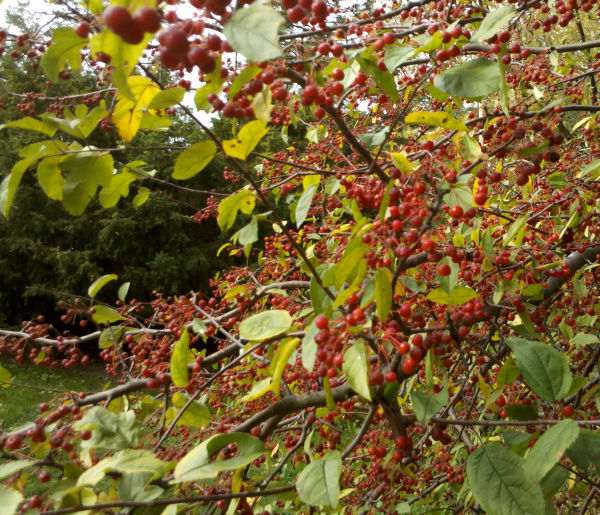
I believe I know the answer but I’m not absolutely sure so I’m asking you, dear readers.
What tree is this with such bountiful fruit? It’s a short, ornamental tree, probably non-native. Notice how the bright red fruit hangs in clusters from the branches. I’m amazed the birds were not eating it yet.
Want to see it for yourself? It’s one of several such trees in Schenley Park on the right side of the walk to the ice rink near Schenley Oval.
If you know its name – or even have a wild guess – leave a comment to let us know.
(photo by Kate St. John)
I think it could be a Cranberry Viburnum.
A Sargent’s Crabapple is my guess. The red fruit is small and the tree doesn’t get much higher than 10-12 feet (maybe a little more depending on soil). It’s a great tree for small spaces for fruit for the birds and even cover. The fruit needs to “cure” before the birds eat it…sometimes they sit all winter with fruit and then suddenly they are gone in a day esp if Cedar Waxwings and Robins are around. Right now the dogwood and pokeweed berries are being devoured since they are softer.
I am thinking after the storm today, most of the leaves will be off my trees…except for the willow which looses it’s tiny leaves after turning yellow and the yard is cleaned of mulched leaves. Thankfully they are small, but can get in the gutters and water feature and cause some problems…The color was beautiful here the last few days with intense red, yellows and oranges in the sun…fall is about over here in the yard…need to try to get as many leaves mulched today BEFORE they fly away.
Is it a china berry? I thought barberry, but I don’t see thorns.
My first thought was some type of viburnum – maybe Viburnum Allegheny, in honor of its location?
Well..it has me googling trees with red berries that’s for sure!
Me too, Kathy! But I think Marcy is right
Hawthorne
I also think it is a crab apple variety. It’s not a viburnum as some have guessed because it has alternate twigs and all viburnums are opposite.
There are hundreds of crab apple cultivars. Some have yellow fruit, some orange, purple or maroon and some have RED. Sargent is one common red fruited variety but so are ‘Red Jade’, ‘Donald Wyman’, ‘Sugar Tyme’ and many others. But since Sargent is the most common in W. PA I will vote with Marcy.
Dianne M
I showed, to one of our botanists, a specimen of what I think is the same plant Kate photographed. The botanist did some research and suggested it might be a cultivar of Japanese Flowering Crabapple (Malus floribundus). She indicated that Sargent’s Crabapple has a mounding habit, which the plant I showed her does not. But I wouldn’t be surprised if more than one crabapple species is planted as an ornamental. Of interest, several websites indicate that Japanese Flowering Crabapple is extinct in the wild.
Tony Bledsoe
University of Pittsburgh
Nothing to add to the guessing game, but the tree in the photo looks rather like one just outside the entrance to my work place of the last three years. The fruit is typically persistent through the winter, and not always eaten by anything before if simply falls to the ground in the late winter / early spring. I’ve seen Cedar Waxwings eating them, but not consistently.